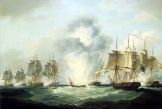
Battle of Cape St. Mary off Portugal, 5 October 1804, which caused the loss of the Mercedes. F. Sartorius, 1807, National Maritime Museum, London.
The American poet Ralph Waldo Emerson once said “Truth is the property of no individual but is the treasure of all men.” This phrase has been ringing in my ears of late as the 17 tons of coins from the ‘Black Swan’ shipwreck were readied for their long-distance flight to Europe. I hope the people of Spain enjoy the stories and lessons that the coins symbolize (after the collection is conserved at an estimated cost of at least $12 million), but I can’t help but wonder if the last five years of ugly legal proceedings have left us short changed in the truth department.
The most troubling dimension of the case that has warped US law is the hyper-sensitive political issue of sovereign immunity. Simply put, warships on exclusively non-commercial ventures still belong to the flag country that launched them; crossings with a commercial component lose this status. The concept is a very modern legal invention that has nothing to do with concerns over sunken archaeology and heritage, but everything to do with protecting modern naval equipment from downed planes to spaceships, submarines, 20th and 21st-century warships, personnel and weaponry, including nuclear missiles.

The Odyssey team examines a cluster of silver & gold coins on the ‘Black Swan’ site. Photo: © Odyssey Marine Exploration.
The frigate Nuestra Señora de las Mercedes was not carrying a black box, advanced weapons or anything that can be considered a State secret. Why did America’s judicial system and the counsel for Spain bulldoze the core reality that, as Odyssey rightly claimed, the majority of the ‘Black Swan’ silver was simply never State property. This is not even a matter of dispute. Take the word of the Spanish academic Julian de Zulueta, writing in a scholarly journal (‘The Battle of Cape Santa Maria 5 October 1804’, Mariner’s Mirror 96.2, 2010: 200-201): on 20 October 1804, Admiral José de Bustamante y Guerra, Rear-Admiral of the Spanish Navy, reported that over 74% of the coins transported on the Mercedes belonged to private merchants (650,000 silver pesos as opposed to the Crown’s 221,000 pesos). It is a misuse of historical sources to ignore the knowledge of a high-ranking Spanish naval officer who commanded the freight’s shipment.
Another twisted truth paraded throughout the Black Swan case is the self-belief that Spain is a long-term guardian of patrimony and knowledge, while Odyssey piratically ransacks the past. These daily accusations have been beyond defamatory and without scientific or historical substance. It is a topsy turvy world when Odyssey burns the midnight oil to publish scores of archaeological papers about shipwrecks of the deep, including the Tortugas shipwreck, a small Spanish merchant vessel lost in 400 metres off the Florida Keys in 1622 and the first ever deep-sea excavation (1990-91), while Spain demonstrates neither the allocation of resources, nor any published results dedicated to shipwrecks.
Unlike the cargoes and personal belongings of the more celebrated 1622 treasure ships the Atocha and Margarita, scattered to the four winds beneath the treacherous Florida Keys, the Tortugas ship sank and settled intact. Despite having been battered and bruised by trawlers since the outbreak of ‘pink gold’ fever for shrimp in Key West in 1949, the wreck contained the largest scientifically-excavated collection of olive jars, tablewares, pearls, animal bones, astrolabes, seeds, and small finds from the end of the Golden Age of Spanish trade with the Americas.
The Tortugas shipwreck was considered so interesting that following its excavation the Spanish government requested Greg Stemm’s assistance for the Seville World Fair of 1992 because the city lacked locally discovered galleon artefacts for display. Stemm and his team happily loaned olive jars, pottery, coins and other valuable artefacts, even paying for the assembly of an exhibit in good faith. But when the fair finished and Stemm asked to collect the artefacts, the Spanish government announced that the fair’s security company had taken the collection because they had not been paid. No compensation or apology was ever forthcoming.
While Odyssey quietly focuses on respecting science, it has been Spain that has publicly licked its lips at the financial value of its sunken past as the Spanish press regale its readership with promises of fantastic galleons lost off its shores. Between 1,500 and 1,800 treasure-laden shipwrecks are said to lie in the country’s territorial waters, and its newspapers have waxed lyrical about the 7.3 million ducats on the San Ignacio, 12,000 kilograms of minted gold, 5,000 kilograms of silver ingots and three chests of emeralds aboard the ill-fated Nuestra Señora del Juncal, and 580,000 gold coins allegedly lost on the Nuestra Señora de la Concepción, without any mention of what their pottery or hulls may contribute to education and science. Spanish magazine and press reports cite local scholars as promising that more than €100,000 million of treasure is submerged in the Bay of Cadiz alone and €160,000 million in all national waters (Andalucia Informacion, 4 September 2010).

One of hundreds of silver coin concretions on the ‘Black Swan’ site. Photo: © Odyssey Marine Exploration.
Juan Manuel Gracia, President of the Association for the Recovery of Spanish Galleons, has gone on the record to say that there is “more gold in the Gulf of Cadiz than in the Bank of Spain” (20 Minutos, 3 October 2011). Equally oddly, Spanish naval sources stress that the country’s debt equals around 10% of the nation’s GDP (about €100,000 million), or less than lies neglected beneath the waves, and have called its sunken gold a “lifesaving miracle to cling to” (Revista Atenea, magazine of the Spanish Navy/Security Forces, 17 June 2009).
Meanwhile, Javier Noriega, Director of Nerea Arqueología Subacuática, has dramatically suggested that for decades Odyssey has “been given permissions for pseudo-scientific missions when all they come for is for the gold and silver of the Spanish”, while “Spain has been the main victim and target during the 20th century. They [treasure hunters] have destroyed sites of extraordinary wealth”. Does this stand up to scientific scrutiny?
Emotional fervour may win political points in pockets of Madrid and Andalusia, but the hyperbole is not supported by my own unrestricted access to Odyssey’s archives. As far back as 1989 Greg Stemm and his team created an electronic recording grid on the 400 metre-deep Tortugas Spanish navio of 1622, a limpet suction device to delicately recover artefacts and a sieve system to safely extract key collections of animal bones and seeds. The exact positions of 16,903 artefacts were plotted, a feat unmatched by Spain in its own shallow-water research and publications.
Similarly, the vast photomosaic plotting the exact positions of hundreds of clumps of coins, 286 copper ingots, 481 four-handled tin ingots, cannon and small finds across an area of 252 x 110 metres on the ‘Black Swan’ site is the most extensive scientific record of the kind produced in marine archaeology. Spain, meanwhile, is yet to publish one colonial-period galleon. If you want to study the archaeology of Spanish trade with the Americas, it is to Florida, Texas, Louisiana and Bermuda that you must turn.
Nevertheless, it has taken the mirage of foreign ‘treasure hunters’ pillaging Spanish waters to stir politicians into action to care for a heritage that has been in trouble for more than 40 years. As early as 1970 Peter Throckmorton warned in Shipwrecks and Archaeology. The Unharvested Sea (London, 1970: 217) that “It is probably safe to say that there are no visible wrecks on the Spanish, French, or Italian coasts under less than one hundred and fifty feet of water which have not been looted and fairly well destroyed.” Pretending that Spain has successfully managed its local underwater patrimony long-term is inaccurate.
Madrid’s answer to the problem, the 2009 Green Paper: A National Plan for the Protection of Underwater Cultural Heritage, reads like a political manifesto rather than a blueprint to map and protect Spain’s sunken heritage. Even the local press has criticized it as “a laudable theoretical exercise” that “violates common sense in a country besieged by crisis, cut backs and State debt” (ABC De Sevilla, 16 June 2010).
Karl Marx’s once tellingly commented that history repeats itself, first as tragedy, second as farce. This moral observation reminds me of Spain’s crusade to see its warships legally recognized as sovereign immune. The profound tragedy was the loss of lives caused by the ships’ sinking that nobody should forget, the “farce” the notion that the world’s nations retain a legal entitlement to the content of historical warships by all practical senses abandoned in far-flung lands – carrying cargoes that were wrested from subjugated natives at the tip of a sword and that never even reached the country that now claims them.
As much as the American counsel for Spain has sugared the pill, history leaves no shadow of doubt that throughout the last 350 years Madrid has shown little cultural interest in its abandoned shipwrecks. In actuality Spain has harnessed the best technologies available to return monetary contents to the stream of commerce. Spanish overlords obliterated the oyster beds of Venezuela in the first two decades of the 16th century (history’s first documented case of unsustainable natural resource depletion by Europeans in the American continent), and in so doing stripped the Bahamas of its 60,000 population of Lucayan Indians as diving slaves. The enslaved divers, dredging and salvage equipment invented to mechanize the harvesting of pearls were later relocated to the wrecked warships the Atocha and Margarita sunk off the Florida Keys in September 1622.
Even though the 1620s recovery of treasure from these ships was technically salvage at the time, Spain has followed the same philosophy aimed at maximum monetary extraction into the modern era. The exploitation of warships sunk in Vigo Bay in northwest Spain is a case in point. The Battle of Vigo Bay of 23-24 October 1702 was a catastrophe for all involved. France’s 15 men-of-war, two frigates and one fireship were all sunk or captured. Of the three galleons and 13 trading vessels in the Spanish fleet, all were destroyed except for five seized as prizes by English and Dutch allies. About 2,000 Spanish and French people lost their lives, while the English and Dutch dead reached 800, making this battle site a real maritime cemetery.
The Spanish galleons had just arrived from America laden with treasure amounting to a suggested 126,470,600 pieces of eight, excluding contraband and the rest of the cargo value. The London Gazette called the Vigo galleons the “richest flota that ever came into Europe”. The loss of the Comercio of Cadiz alone was said to be worth eight million pieces of eight and in total an estimated 113,396,085 pieces of eight are said to have sunk. Like the Nuestra Señora de las Mercedes blown up in 1804, the vast majority of the cargo was private property, in this case owned by Cadiz merchants and traders from England, France, Holland and other European countries for whom they acted as agents.
Down the centuries Spain consistently encouraged private enterprise in Vigo Bay. From 1723-48 no less than 17 concessions were granted by Spain to salvors using everything from drags to diving bells. Chests of silver were recovered in 1728, and in 1825 an English expedition found silver plate bearing the arms of Spain and the date 1691, cannon, bombs, artistic and precious objects, coins and ingots. The government readily took its 80% cut.
The open embrace to foreign salvage continued in 1869, when the valuable articles found by the French engineer M. Bazin included a massive turtle crafted of native silver, as well as wood, guns and silver plate. In 1885 the Philadelphia based Vigo Bay Treasure Company lifted a hull, which broke up because it was insufficiently strengthened. Spain considered such cultural devastation to be an acceptable casualty of profit.
In 1904 Carlos Iberti travelled to Madrid and obtained a permit from the Spanish Government to search Vigo Bay using Giuseppe Pino’s famous submarine. Spain bent over backwards to support his commercial scheme in an age when archaeology and awareness of heritage were advanced. As Iberti wrote, “In Madrid valuable friends awaited me at every step: Cabinet Ministers, Under-Secretaries of State, Members of Parliament, Generals and Admirals all took the deepest interest in the enterprise, and vied with each other in offering me their powerful aid… In three months my negotiations with the Government of His Majesty Alphonso III brought me a Royal Decree, which, sanctioned by the Council of Ministers, bears the signature of his Excellency General Don José Ferrandiz, the present Naval Minister… I return to Italy, full of dreams…” Spain even dispatched its finest destroyer, the Clemente, to assist the Italian’s commercial venture.
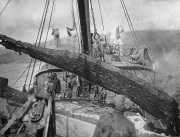
1924 Italian expedition raising a galleon keelson from Vigo Bay. From Treasure Divers of Vigo Bay by John S. Potter (New York, 1958).
A hundred years before Odyssey Marine Exploration formulated the idea of classifying finds into ‘Trade Goods’ and ‘Cultural Artifacts’ categories, Spain applied a similar entrepreneurial model. As well as handing over 20% of all finds to the State, an extension to Iberti’s first concession dating to 24 August 1907 legislated for cultural artefacts to be retained by Spain in return for the market value of the object: “In fulfillment of what has been established by Art. 351 of the Civil Code, if any objects of interest to Science or Art or of any historic value should be extracted, they shall be given to the State, if it is required, and the State will pay the fair price, which will be fixed by experts, taking into account the expenses of their recovery.”
The arc of Spain’s eagerness to salvage since 1622 off the Florida Keys prevailed in Vigo Bay into the mid-20th century. Italian teams continued operations under the direction of Iberti, Count George Khevenhüller of Austria and the engineer Enrique Venturini in 1924, when they dredged the sunken fleet using a half-ton grab bucket suspended from a boom, which bit vast holes through the mud down to the ballast of every buried wreck. What is variably described as the 23-foot bowsprit or rudder assembly of the Almirante was lifted. Just before World War II a Dutch team brought a diving bell to Vigo Bay fitted with dredging equipment mounted on its open lower end, salvaged for 18 months, charted the positions of over 20 wrecks and raised tons of ships’ frames and planks. Several tons of hull were lifted from the Canoto in 1939.
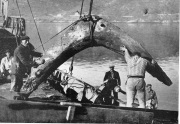
1924 Italian expedition raising part of a ‘galleon’s prow’ from Vigo Bay (more probably a floor timber). From Treasure Divers of Vigo Bay by John S. Potter (New York, 1958).
Spain’s commercial salvage of the Vigo Bay treasure ships continued as late as 1955, when John Potter received a three-year concession from the Ministry of Marine under the following conditions: “The Spanish State will be entitled to the entire property of all that is salvaged, paying to the concessionary, in Spanish national currency, a 50 per 100 of its value while the extracted goods do not exceed one million pesetas and a 40 per 100 of such as exceed said amount… The Spanish State, however, reserves the rights to disclaim in favor of the concessionary… the property of such objects that are not considered worthy of conservation, without having to pay any price for the extraction thereof.” Irrespective of whether great riches truly ever ended up on the bottom of Vigo Bay in 1702, Spain’s subsequent 253 years of commercial salvage must go down as history’s most extensive continuous attempt by any nation to recover ‘treasure’.
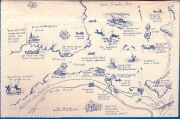
Map of Spanish galleons in Vigo Bay. From Treasure Divers of Vigo Bay by John S. Potter (New York, 1958).
In declaring the Black Swan silver Spanish patrimony, the US Court has trampled into the ground a field of well-planted precedents. As recently as 1965 the Marquis de Morry del Val, Spanish Ambassador to the United States, admitted by letter quite candidly in relation to the newly discovered 1715 Plate Fleet off Florida that Spain had lost its claim to the treasure when it abandoned all efforts at recovery. The USA’s subsequent legal declaration of the Atocha and Margarita as Fisher property should serve as a clear precedent favouring the salvor (as it has for the past 2,500 years) in the ‘Black Swan’ case, a conclusion made even easier by this site’s location in international waters. Fidel Castro’s galleon hunting company Carisub has salvaged numerous Spanish warships and merchant vessels off Cuba (over 100 colonial wrecks according to press reports). Again Spain turned a blind eye.
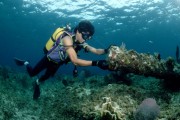
A Carisub diver examining a cannon on a Spanish galleon wreck off Cuba. Photo: © Arne Hodalic/CORBIS.
Madrid’s disinterest in its numerous shipwrecks discovered by divers and salvage teams – commercial and military –is a telling indication of the country’s acceptance of abandonment as a practical precedent. Lost 80 kilometres south of Louisiana en route from Vera Cruz and New Orleans in 1784 with 450,000 pesos, for instance the 5.5 tons of coins recovered from the wreck of the Spanish brig of war El Cazador were awarded to the finder with no Spanish challenge. In this light, Spain’s crusade against Odyssey bears all the hallmarks of lashing out at a political scapegoat, using the threat of potential loss of sovereign immunity over modern warships, submarines, sailors, soldiers and downed nukes to twist the USA’s arm behind its back.
My personal view is that the former Spanish government’s disproportionate pursuit of previously unknown and inaccessible underwater cultural heritage, symbolized by the ‘Black Swan’ case, has been triggered not by passion for the past but by residual historical insecurities over loss of empire. This is a great shame. Spain is a country with dazzling history, immense culture, noble traditions and wonderful underwater archaeology needing study.
Despite all the silly talk of the financial value of lost galleons, in truth the wrecks in the Gulf of Cadiz (also related to the Battle of Trafalgar of 1805) and lost in Vigo Bay in 1702 are largely so deeply buried under centuries of mud swept down from rivers that actually for once they really can be preserved in situ. As the 400 metre-deep Tortugas shipwreck shows, not to mention the promise of the ‘Black Swan’ site, greater potential for Spanish underwater archaeology lies far offshore.
For the past two decades Odyssey has endlessly reached out to Spain to collaborate in the study of heritage sunk beyond its territorial waters. If Madrid had agreed, then large swathes of Spain’s seas could have been mapped by now in the same way that Odyssey recorded 267 wrecks in 2005-08 across 4,725 square nautical miles of the western English Channel and Western Approaches for much less than Spain has spent pursuing the ‘Black Swan’ case through the Courts. Not one artefact from these English Channel wrecks has been sold, but Odyssey has contributed significantly to the archaeological record through their publications.
Perhaps with a change of government it is an opportune time for common sense to surface and for some Spanish officialdom to stop tilting at windmills and look to the future. Odyssey in the meantime will continue to respect sunken Spanish heritage, this year publishing a range of scientific reports on the 1622 Tortugas wreck, its ceramics, animal bones, beads, pearls, hull and ballast.
Plans are also afoot to publish a report on the Black Swan site, which despite scaremongering was respectfully recorded. Here lies the greatest irony of the Black Swan tale. Divorced from its archaeological context, the silver coin hoard from the Mercedes is comparatively meaningless: these coin types are hardly unknown. The silver may now have landed in Spain, but thanks to the company’s scientific documentation of this wreck site Odyssey possesses the true treasure – knowledge that it plans to share with the world’s scientists and society.
Not once in the last five years of relentlessly pursuing the ‘Black Swan’ silver has Spain and its American legal team requested a duplicate archive of the project science to try and really understand this shipwreck. Led by its US counsel and dogma, Spain has shown more interest in treasure than truth.

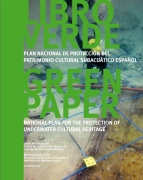
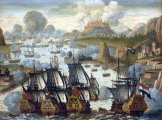
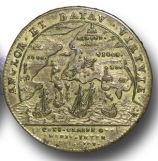
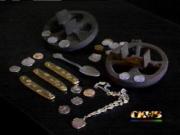
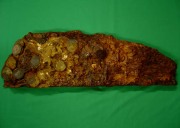
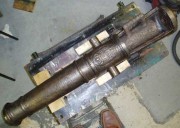
Marvelous article, very enlightening. Especially when seen in the light of the political associations of Spain’s American attorney, He is on the Board of Directors of RPM Nautical as well as being deeply involved with the Institute of Nautical Archaeology at Texas A&M. His firm Covington and Burling of Washington DC was also the law firm of our current Attorney General, Eric Holder. This same attorney can regularly be seen on panels with folks from the State Dept., Commerce and Justice all in the name of concern for the “resource”. This coupled with the State Dept., back room dealings vis-a-vis wikileaks, really shows the dark underbelly of the machinations that occur around this issue. Folks can wave the sacred cultural patrimony flag all they want under all sorts of guises, UNESCO’s CPUCH etc. etc. it all comes down to the same issue at the end. Your science might be impeccable, your methodology the best, the conservation techniques, second to none the bottom line is what it is about, and who gets to do it (recover shipwrecks i.e. who will be paid)? Are you in the club? And “who gets the goodies” the rest is just smoke and mirrors.